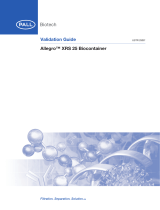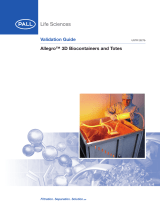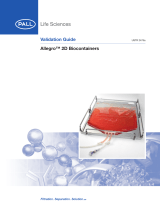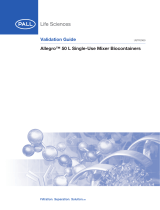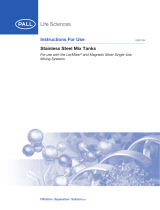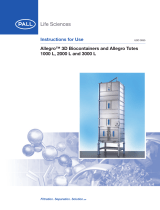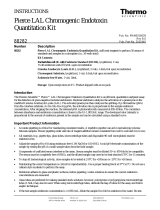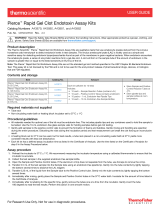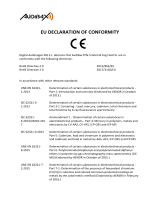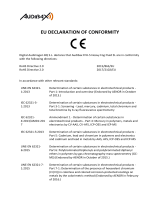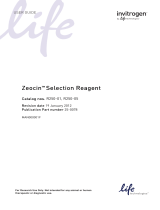Page is loading ...

USTR 2924
Validation Guide
Allegro™ STR 200 Biocontainer

2
Table of Contents
1. Introduction..................................................................................................................................................3
2. Summary of Conclusions ............................................................................................................................4
3. Extractables/Leachables Study ..................................................................................................................5
3.1 Introduction..............................................................................................................................................5
3.2 Summary of Extractables/Leachables Methods for the Allegro Biocontainer Film and
Polyethylene Material used for Molded Connection Pieces ......................................................................5
3.3 Summary of Extractable/Leachables Methods for Additional Materials used in the
Allegro STR 200 Biocontainer ..................................................................................................................7
3.4 Extractables/Leachables Testing Results..................................................................................................8
4. Biological Safety Tests .............................................................................................................................10
4.1 Introduction............................................................................................................................................10
4.2 Summary of Biological Safety Test Methods ..........................................................................................10
4.3 Biological Testing Results ......................................................................................................................12
4.4 Biological Safety Test Conclusions ........................................................................................................12
5. Physico-chemical Tests.............................................................................................................................12
5.1 Introduction............................................................................................................................................12
5.2 Summary of Physico-chemical Test Methods ........................................................................................13
5.3 Physico-Chemical Test Results ..............................................................................................................15
6. Shelf Life Studies.......................................................................................................................................17
6.1 Introduction............................................................................................................................................17
6.2 Summary of Methods ............................................................................................................................18
6.2.1 Leak Test ......................................................................................................................................18
6.2.2 Tensile Strength Test and Peel Test ..............................................................................................18
6.3 Shelf Life Testing Results ......................................................................................................................20
6.4 Conclusions ..........................................................................................................................................21

1. Introduction
This guide contains data applicable to the Allegro STR 200 single-use biocontainer designed for use with
the Allegro STR 200 system. This stirred tank reactor is a single-use, cell culture system that consists of
three major components: 1) an Allegro STR 200 Tote, 2) a single-use Allegro STR 200 Biocontainer and 3)
an Allegro STR 200 Controller. This validation guide focuses on the second component, the biocontainer,
which is a flexible, gamma irradiated plastic bioreactor used to culture up to 200 L of mammalian cells.
The biocontainer is equipped with a pitched blade impeller driven by a motor at the base of the tote.
The rotation of the impeller induces fluid motion inside the biocontainer and facilitates cell suspension,
efficient gas exchange, and liquid mixing. The purpose of this guide is to document the validation testing
that has been performed to demonstrate the suitability of the Allegro STR 200 biocontainer to culture
cells for use in the biotechnology industry.
The Allegro STR 200 biocontainers are made of a low density polyethylene (LDPE) film which complies
with the very high standards of quality required for biotechnology and pharmaceutical applications.
The component parts of the Allegro STR 200 biocontainer are shown in Figure 1 and Table 1. These
are also made from very high quality materials and tested as per the guidelines for biotechnology and
pharmaceutical applications.
This validation guide summarizes the tests performed to qualify the Allegro STR 200 biocontainers
for use in cell culture applications.
IMPORTANT NOTE: As indicated in the text, some of this validation data was generated during the
original qualification of other Allegro biocontainers (Pall publications USTR 2475 Allegro 2D Biocontainers
Validation Guide, USTR 2527 Validation Guide for Allegro 3D Biocontainers and Totes, USTR 2900
Allegro XRS 20 Biocontainer Validation Guide and USTR 2777 Pall Allegro Single-Use Mixers) as the
materials and methods of construction are the same. To have copies of these validation guides please
contact Pall at [email protected].
Figure 1
Allegro STR 200 Biocontainer Schematic
www.pall.com/biopharm 3
Temperature and DO
Probe Seals (not shown)
Platinum Cured Silicone
Drain Valve
Polyethylene/Polysulfone
(Validated as part of 2D/3D
Allegro Biocontainer validation)
Port Manifolds
Polyethylene
(Validated as part of 2D/3D
Allegro Biocontainer validation)
Top Cover
Polyethylene
(Validated as part of 2D/3D
Allegro Biocontainer validation)
Impeller/Endcap Polysulfone
(Validated as part of Allegro
Single Use Mixer validation)
Seal Housing Polysulfone
o Biocontainer validation)Allegr
alidated as part of 2D/3D
(V
Validated as part of 2D/3D
Polyethylene
op Cover
T
Top Cover
Polyethylene
Port Manifolds
o Biocontainer validation)
alidated as part of 2D/3D
o Biocontainer validation)Allegr
alidated as part of 2D/3D
(V
Validated as part of 2D/3D
ed SiliconePlatinum Cur
obe Seals (not shown)Pr
e and DO
emperatur
T
Tempe ra tu r
Seal Housing Polysulfone
Single Use Mixer validation)
alidated as part of Allegr
(V
Validated as part of Allegr
Impeller/Endcap Polysulfone
o Biocontainer validation)
alidated as part of 2D/3D
ed Silicone
obe Seals (not shown)
e and DO
Seal Housing Polysulfone
Single Use Mixer validation)
o alidated as part of Allegr
Impeller/Endcap Polysulfone
o Biocontainer validation)Allegr
alidated as part of 2D/3D
(V
Validated as part of 2D/3D
Polyethylene/Polysulfone
alve
Drain V
Valve
o Biocontainer validation)
alidated as part of 2D/3D
Polyethylene/Polysulfone
P

4
2. Summary of Conclusions
Extractables/Leachables Study
The purpose of this study was to characterize the chemicals that may be extracted/leached from typical
Allegro biocontainers when exposed to different solutions and at specified temperatures for 30 and 90
days. All other Allegro STR 200 biocontainer parts in direct contact with cell culture fluid were tested
separately (see Table 1). The results indicate low extractables/leachables levels when tested under
specified conditions.
Biological Safety Tests
The materials used in all Allegro biocontainers [polyethylene and ethylene-vinyl alcohol copolymer
(EvOH)] meet the requirements of the USP Biological Reactivity Tests (in vivo) for Class VI - 50 °C
plastics. Specifically these tests assess the effect of biocontainer extracts for systemic toxicity, tissue
irritation, and biocompatibility upon implantation. The materials used in the biocontainers meet the
requirements for ISO 10993 Biological Evaluation of Medical Device in section 4 (Hemolysis),
5 (Cytotoxicity), 6 (Implantation test), 10 (Irritation and sensitization test) and 11 (Acute systemic toxicity).
Additional parts unique to the biocontainer used in Allegro STR 200 bioreactor, which were not covered
by the original Allegro biocontainer tests, namely the impeller (polysulfone), sparger, (polyethylene), seal
housing (polysulfone), and temperature and DO probe seals (platinum cured silicone elastomers) all meet
the requirements of USP<88> Biological Reactivity Tests (in vivo) for Class VI-121 °C Plastics Testing and
USP <87> Biological Reactivity Tests (in vitro).
Physico-chemical Tests
The purpose of these tests was to evaluate the physico-chemical suitability of the Allegro biocontainers
for USP <661> Containers - Plastics, European Pharmacopoeia (sec. 3.1.5), and Japanese
Pharmacopoeia (Sec. 61 Part 1) standards, USP<788> Particulate Matter in Injection and USP<85>
Bacterial Endotoxins. The components of the Allegro 3D biocontainers meet the requirements of all
these standards.
In addition to the above, testing was also performed on materials used for construction of the Allegro
STR 200 Biocontainer, but not included in the original Allegro biocontainer tests. The results show that
the impeller (polysulfone), sparger (polyethylene), seal housing (polysulfone), and temperature and DO
probe seals (platinum cured silicone elastomers) all meet the requirements of USP <661> Containers –
Plastics, USP<788> Particulate Matter in Injection and USP<85> Bacterial Endotoxins.
Shelf Life Tests
Nine fully assembled Allegro STR 200 biocontainers were subjected to shelf life testing immediately after
gamma irradiation and again after accelerated aging equivalent to 6 months of real time aging. Stirring
and water leak tests, peel tests on connectors, and tensile strength tests on the outer welds, top plate,
bottom drain port, and cross crease fold, were performed. The results demonstrate that functionality of
the biocontainers remained intact after gamma irradiation and 6 months of accelerated aging. A three
year shelf life study is currently underway. Interim reports for longer time periods will be available upon
request (bior[email protected]) as data become available.

Table 1
Results Summary for all Allegro STR 200 Parts Tested
% of Total
Biocontainer E/L USP USP USP USP USP
Fluid Contact Part* Material Surface Area tests <85> <88> <87> <661> <788>
Biocontainer Film Polyethylene 80.5 YYY YY Y
(Class VI-50 °C)
Molded Connection Pieces Polyethylene 11.75 YYY YY Y
(Drain Valve Flange/ (Class VI-50 °C)
Port Manifolds /Topcover)
Endcap/Impeller/ Polysulfone 4.90 YYY YY Y
Drain Valve Spigot (Class VI-50 °C)
Sparger Rings Polyethylene 1.70 YYY YY Y
(Class VI-121 °C)
Seal Housing Polysulfone 0.90 YYY YY Y
(Class VI-121 °C)
Seal around Temperature/ Platinum Cured 0.05 YYY YY Y
DO Probe Silicone Rubber (Class VI-121 °C)
* group of parts to which the material test applies
E/L = extractables/leachables
Y = completed tests that meet indicated standards
3. Extractables/Leachables Study
3.1 Introduction
The purpose of the extractables/leachables study was to characterize and semi-quantify the
volatile and non-volatile residues or components that may be extracted/leached from typical
Allegro biocontainers, which includes the Allegro STR 200 biocontainer, when exposed to
different solutions.
All Allegro 2D and 3D biocontainers use the same manufacturing method and materials of
construction for the film and molded connection pieces. Therefore, the extractables/leachables
test results are applicable for all types of Allegro biocontainers, including the Allegro STR 200
biocontainer. The data presented is taken from the validation of 2D and 3D Allegro biocontainer.
The additional fluid contact parts unique to the construction of the Allegro STR 200 biocontainer
were also tested as part of this validation. A schematic of the biocontainer, showing the additional
components and their location within the container, can be seen in Figure 1. These components
are listed described in Table 1, along with information about the type of material, the percentage
of total fluid contact surface area comprised by the specific part(s), and the test results.
3.2 SummaryofExtractables/LeachablesMethodsfortheAllegroBiocontainerFilmand
PolyethyleneMaterialusedforMoldedConnectionPieces.
The Allegro biocontainer with molded connection pieces were gamma irradiated at a dose
≥26 kGy. Subsequently, samples of the biocontainers and additional components were
extracted for 30 and 90 days as described in Table 2.
www.pall.com/biopharm 5

6
Table 2
Contact Fluids and Tests Applied to Allegro Biocontainers
Contact Fluid
Tween
PBS– PBS– NaCl 80–1% Ethonal DMSO
Analytical Test Methods pH3 WR pH11 3M in WR 96% 10%
Allegro biocontainer lling ABC ABC ABC ABC ABC BC BC
and recording of weight
(empty + lled)
pH Measurement ABC ABC ABC ABC ABC BC BC
Conductivity ABC ABC ABC
Total Organic Carbon (TOC) ABC ABC ABC
Metals (ICP-OES) ABC ABC ABC ABC ABC BC BC
Headspace GC-MS ABC ABC ABC ABC ABC BC BC
Solvent Extraction + GC-MS ABC ABC ABC ABC ABC BC BC
Solvent Extraction + LC-MS ABC ABC ABC ABC ABC BC BC
Ion Chromatography ABC ABC ABC ABC ABC BC BC
Derivization GC-MS ABC ABC ABC ABC ABC BC BC
40 ºC 40 ºC 40 ºC 40 ºC 40 ºC 25 ºC 25 ºC
75% RH 75% RH 75% RH 75% RH 75% RH
Storage Conditions
Biocontainer – 30 Day Incubation = A, Biocontainer – 90 Day Incubation = B, Control – Gas Bottle = C
PBS is phosphate buffered saline, WFI is water for injection, DMSO is dimethyl sulfoxide, and RH is relative humidity, ICP
is inductively coupled plasma, GC is gas chromatography, LC is liquid chromatography, MS is mass spectrometry.
Seven test bags were constructed from the Allegro biocontainer film and the polyethylene
material used for Allegro molded connection pieces. These bags, with an internal surface area
of 1625 cm2and a maximum volume of 5 liters, were each filled with 3.25 L of contact fluid
(table 2) via a peristaltic pump to provide an extraction ratio of 2 mL per cm2of test film material.
Once filled, they were stored under conditions specified in Table 2 for 30 or 90 days.
The extractable/leachable test fluids were analyzed as described in Table 2 and data from the
bags made using the Allegro biocontainer film were compared with control samples from a glass
bottle. The glass bottle control samples were stored at the same conditions as the test samples.

3.3 SummaryofExtractable/LeachablesMethodsforAdditionalMaterialsusedinthe
AllegroSTR200Biocontainer
Extractables/leachables tests for Allegro STR 200 biocontainer components (sparger, impeller*,
seal housing and silicone probe seals) were conducted by submerging each material part
in contact fluid, either ethanol or water for injection (WFI), at 40 °C for 30 days. Reference
extractions were set up in parallel, using glass bottles. Test materials and glass bottles were
irradiated at 50 +/-5 kGy prior to the test. The same surface area/volume ratio of 2 cm2/mL
of extraction solvent for each material was applied. The samples were then subjected to the
analytical tests described in Table 3.
*Impeller study done as part of Allegro single-use mixer validation
Table 3
Experimental Design for Extractables Testing on Additional Allegro STR 200 Biocontainer
Components
Seal around
Temperature/DO
Fluid Contact Part Endcap/Impeller Sparger Ring Seal Housing Probe
Ethanol Ethanol Ethanol Ethanol
Extraction Solution WFI 96% WFI 96% WFI 96% WFI 96%
pH Measurement ✔✔ ✔ ✔
Conductivity ✔✔ ✔ ✔
Total Organic ✔✔ ✔ ✔
Carbon (TOC)
Metals (ICP) ✔✔ ✔ ✔ ✔ ✔ ✔ ✔
Headspace GC/MS ✔✔ ✔ ✔ ✔ ✔ ✔ ✔
GC/MS ✔✔ ✔ ✔ ✔ ✔ ✔ ✔
LC/MS ✔✔ ✔ ✔ ✔ ✔ ✔ ✔
Residue on ✔✔ ✔ ✔ ✔ ✔ ✔ ✔
Evaporation (NVR)
Anions (IC) ✔✔ ✔ ✔ ✔ ✔ ✔ ✔
www.pall.com/biopharm 7

8
3.4 Extractables/LeachablesTestingResults
Extractables/Leachables Results for Allegro Biocontainers
The bags made using the Allegro biocontainer film, together with polyethylene material used for
the molded connection pieces (after gamma irradiation at ≥26 kGy), were filled with 7 different
contact fluids. No significant loss in weight (evaporation), change in pH or change in conductivity
was observed after 30 days and 90 days exposure to the contact fluids. The fluid analysis after
90 days of contact revealed low concentrations of extractables in comparison to the glass bottle
used as a control. Virtually all identified extracted/leached chemical entities attributed to the
biocontainer (Table 4) are explainable as either oligomers of polymer used or degradation
products from the antioxidants used.
Table 4
Analytical Summary of Extractables/Leachables Analysis for Allegro Biocontainers, Comprised
of Allegro Film and Molded Connection Pieces
Contact Fluid / Extractant
96% 1% 10%
Level WFI PBS-pH3 PBS-pH 11 3M NaCl Ethanol Tween 80 DMSO
2-10 ppm 1-3-di-tert-
buthylbenzene
1-2 ppm TOC TOC C8-alkenes
0.1-1 ppm Acetate TOC Fatty Acetate, AOx 1-octene 1-3-di-
Hexanal acids degradation, C8-alkenes tert-
Alkenes (C9+) Methylcyclo buthyl
pentane benzene
1-3-di-tert- AOx
buthy
lbenzene
10-100 ppb Acetate AOx 2-methyl-1- Di-tert- Alkanes
AOx degradation/ propene butylphenol
degradation/ Di-tert- Di-tert-
Di-tert- butylphenol butylphenol
butylphenol
5-10 ppb 2-methyl-1- Antioxidants Hexanal
propene
2-octanone
<5 ppb Antioxidant Antioxidants
2-methyl-1-
propene
ppm is parts per million, ppb is parts per billion
Extractables//Leachables Results for the Additional Materials Used in the Allegro STR
200 Biocontainer.
Contact fluids did not show a significant change in pH or conductivity after 30 days of contact.
Additionally, virtually all identified extracted/leached chemical entities are explainable as
oligomers of polymer used, polymer additives, or degradation products from the antioxidants
used (Table 5).

Table 5
Summary of Extractables/Leachables Data for Additional Parts Used for the Allegro STR 200
Biocontainers
Contact Fluid / Extractant
Level WFI Ethanol
>100 ppm Alkanes
10 ppm – 100 ppm TOC 1,3-Di-tert-butylbenzene
fatty acids
5 ppm – 10 ppm 2,4-Di-tert-butylphenol,
Ethyl hexadecanoate
AntiOx degradation products
1 ppm – 10 ppm Chloride, Nitrate, Acetate, Formate Acetate, Formate, TOC
Chlorobenzene
0.1 ppm – 1 ppm AntiOx degradation products 2-methyl-1-propene (1), Hydrocarbons
Ca, Na Ca, Al, Fe, K, Na, Zn
1 ppb – 100 ppb 2-methyl-1-propene (1), Cu, Mg
AntiOx degradation Products, Isomer of Chloromethylphenol (1)
2-methyl-1-propanol, Amide (2)
2,2-Dimethylpropanoic acid (1),
Octanone
Amide (2)
Polyethoxylated Compound (2)
Fatty acids
Al, Cu, Fe, K, Mg, Zn
(1) Most probable compound
(2) Tentatively Identied
Extractables/Leachables Testing Conclusions
The results from the Allegro biocontainer testing after 30 and 90 days indicate that the level of
extractables/leachables for tested contact fluids was extremely low (Tables 4 and 5), especially
for the WFI and PBS contact fluids, which most closely match actual application conditions.
Additional extractables/leachables test results from parts used in the construction of the Allegro
STR 200 biocontainers also show low levels of extractables. Virtually all identified extracted
chemical entities are explainable as oligomers from the polymers, polymer additives, or
degradation products from the antioxidants.
As expected, the ethanol extraction showed higher concentrations of the detected compounds
for most parts tested. The levels seen in the water extract were much lower, which suggests that
the compounds have limited solubility in water. The components tested account for a very small
proportion of the total surface area of the biocontainer and therefore the concentration of the
detected compounds should be viewed in that context. For example, TOC detected for the
sparger component was 10 ppm in extraction volume. The area of the sparger ring as a
percentage of the whole system is 1.64% and therefore the sparger would contribute only
extremely low TOC to the whole biocontainer.
More detailed information on the results of extractables/leachables study is available upon
request (at bior[email protected]).
www.pall.com/biopharm 9

10
4.0 Biological Safety Tests
4.1 Introduction
The purpose of these tests was to evaluate the biological suitability of the materials of construction
of Allegro STR 200 biocontainers. Allegro 2D and 3D biocontainers use the same manufacturing
method and same material of construction for the film, drain valve, port manifolds and top cover.
Additionally, the endcap and impeller from the Allegro mixer are made of the same material and use
the same method of construction. Therefore, the biological safety test results for these products are
applicable for all Allegro biocontainers. Table 6 lists the biological safety tests performed on these
parts as well as on newly validated parts Allegro STR 200 biocontainer components.
Table 6
List of Tests Applied for Each Allegro STR 200 Biocontainer Fluid Contact Part
Fluid Contact Part Test Type Test Results From
Biocontainer Film USP 88 Class VI-50 °C / 2D/3D Allegro biocontainer validation
USP87 & ISO10993
Molded Connection Pieces USP 88 Class VI-50 °C / 2D/3D Allegro biocontainer validation
(Drain Valve Flange/Port Manifolds / USP87 & ISO10993
Topcover)
Endcap/Impeller USP 88 Class VI-50 °C / USP87 Allegro single-use mixer validation
Sparger Ring USP 88 Class VI-121 °C & USP87 Allegro STR 200 biocontainer validation
Seal Housing USP 88 Class VI-121 °C & USP87 Allegro STR 200 biocontainer validation
Seal around Temperature/DO Probe USP 88 Class VI-121 °C & USP87 Allegro STR 200 biocontainer validation
4.2 SummaryofBiologicalSafetyTestMethods
Tests include USP Biological Reactivity Tests, in vivo for Class VI Plastics (50 °C / 121 °C) as
described in the current United States Pharmacopoeia Chapter <88>, USP Biological Reactivity
Tests, in vitro as described in the current United States Pharmacopoeia Chapter <87>, and
ISO10993 Biological Evaluation of Medical Device.
USP <88> Biological Reactivity Test – In Vivo for Class VI-50 °C Plastics
The Biological Reactivity Tests in vivo for Class VI-50 °C Plastics as described in the United
States Pharmacopoeia include:
• Injection of extracts of plastic materials
• Implantation of the solid material into animal tissue.
The four extracting media listed in the USP simulate parenteral solutions and body fluids.
These include:
• 0.9% Sodium Chloride for Injection
• 1 in 20 Solution of Ethanol in Sodium Chloride Injection
• Polyethylene Glycol 400
• Vegetable Oil (sesame or cottonseed oil).
Samples of gamma irradiated (50 kGy) biocontainer film, impeller material and molded
connection piece were extracted with these solutions at 50 +/- 2 °C for 72 +/- 2 hours.
The additional materials used in the Allegro STR 200 biocontainer, namely the sparger ring, seal
housing material, and silicone probe seals, were gamma irradiated (50 kGy) and extracted with
these solutions at 121 °C +/- 2 °C for 60 mins.

The extracts were then used in the following tests to assess biological effects:
Acute Systemic Injection Tests
An Acute Systemic Injection test was performed to evaluate the potential of a single injection
of an extract to produce systemic toxicity. Extracts in Sodium Chloride Injection and 1-in-20
Solution of Ethanol in Sodium Chloride Injection were injected intravenously. Cottonseed oil
extract and Polyethylene Glycol 400 extracts were injected intraperitoneally.
Intracutaneous Tests
An Intracutaneous test was performed to evaluate the potential of a single injection of an extract
to produce tissue irritation. All four of the extracts listed above were used for these tests.
Implantation Tests
Implantation tests were performed, in order to subject the Allegro biocontainer material
of construction to the most stringent conditions included in the USP.
USP <87> Biological Reactivity Tests After 50 kGy Gamma Irradiation
The purpose of this study was to assess cytotoxicity (i.e., the effect of extractable from test
material on the test cells) as per USP <87> guidelines. An extract of the test article, gamma-
irradiated to 50 kGy, was prepared using single strength medium essential medium (1X MEM)
supplemented with 5% serum and antibiotics. This test extract was placed onto two separate
monolayers of L-929 mouse fibroblast cells. Two separate monolayers were prepared for the
negative control (high density polyethylene) and the positive control (tin stabilized polyvinylchloride).
All monolayers were incubated at 37 ºC in the presence of 5% CO2for 48 hours then examined
microscopically to assess changes in cell morphology. The negative and positive controls per-
formed as anticipated. Extracts from test materials showed no evidence of a cell lysis or toxicity
effect on the L-929 cells, thus meeting the requirement of the USP <87> standards.
ISO 10993 Biological Evaluation of Medical Devices
Gamma irradiated (≥26 kGy) samples of the film and of the molded connection pieces were
tested for the following sections of ISO 10993:
• ISO 10993-4 Hemolysis
This study assesses the haemolytic activity, i.e. the effect of test material on the cellular
components of the blood, by placing the test material in direct contact with the human blood.
• ISO 10993-5 Cytotoxicity
The purpose of this study was to assess cytotoxicity, i.e. the effect of extractable from test
material on the test cells, by adding the extracts to a cell culture. The samples were tested using
a direct contact method. A negative result indicates that a material is free of harmful extractables
or has an insufficient quantity of them to cause acute effects under these conditions with
isolated cells.
• ISO 10993-6 Implantation test
The purpose of this study was to test and evaluate the test material for the potential to induce
local toxic effects after implantation in the muscle tissue of animals during 2 weeks.
• ISO 10993-10 Irritation and sensitization test
The purpose of this study was to test extracts from test materials for irritation effects upon
intracutaneous injection in animals. The test materials were extracted with sodium chloride
for injection and cottonseed oil at 70 ± 2 °C for 24 ± 2 hours.
• ISO 10993-11 Acute systemic toxicity
The purpose of this study was to test the extracts from test materials for their potential toxic
effects as a result of a single-dose systemic injection in animals. The test materials were
extracted with sodium chloride for injection and cottonseed oil at 70 ± 2 °C for 24 ± 2 hours.
www.pall.com/biopharm 11

12
4.3 BiologicalTestingResults
A summary of the Biological Safety Testing is shown in Table 7. All materials used in the
construction of the Allegro STR 200 biocontainer met the test requirements as defined
by the indicated protocols.
Table 7
Summary of the Biological Safety Test Results for the Allegro STR 200 Biocontainer
Fluid Contact Part Test Type Test Results
Biocontainer Film USP 88 Class VI-50 °C / USP87 Met all requirements
and ISO10993
Molded Connection Pieces USP 88 Class VI-50 °C / USP87 Met all requirements
(Drain Valve/Port Manifolds / and ISO10993
Topcover)
Endcap/Impeller USP 88 Class VI-50 °C and USP87 Met all requirements
Sparger Rings USP 88 Class VI-121 °C and USP87 Met all requirements
Seal Housing USP 88 Class VI-121 °C and USP87 Met all requirements
Seal around Temperature/DO Probe USP 88 Class VI-121 °C and USP87 Met all requirements
4.4 BiologicalSafetyTestConclusions
All materials used in the Allegro STR 200 biocontainer meet the requirements of the USP
Biological Reactivity Tests, in vivo, for Class VI Plastics (USP <88>) and USP Biological
Reactivity Tests, in vitro, Cytotoxicity (USP <87>).
5.0 Physico-chemical Tests
5.1 Introduction
The intent of these tests was to evaluate the physico-chemical properties of Allegro biocontainers.
The purpose of USP <661> test, European Pharmacopoeia guidelines section 3.1.5 test,
Japanese Pharmacopoeia guidelines section 61 Part 1, USP<788> and the European and US
Pharmacopoeia (respectively 2.6.14 and USP <85>, current edition) standards was to check
that the materials of Allegro biocontainers meet specific physico-chemical test requirements.
Table 8 lists physico-chemical tests used for each of the components in the Allegro STR 200
biocontainer.

Table 8
Physico-chemical Tests Performed for the Allegro STR 200 Biocontainer Components
Fluid Contact Part Test Type Dataset
Biocontainer Film USP<661> Validated as part of 2D/3D Allegro biocontainer validation
EP3.1.5
JP(Sec61Pt1)
USP<788>
EP2.6.14
USP<85>
Drain Valve Flange/Port USP<661> Validated as part of 2D/3D Allegro biocontainer validation
Manifolds/Topcover EP3.1.5
JP(Sec61Pt1)
USP<788>
EP2.6.14
USP<85>
Endcap/Impeller USP<661> Validated as part of Allegro single-use mixer validation
USP<788>
USP<85>
Sparger Ring USP<661> Tested as part of Allegro STR 200 biocontainer validation
USP<788>
USP<85>
Seal Housing USP<661> Tested as part of Allegro STR 200 biocontainer validation
USP<788>
USP<85>
Seal around USP<661> Tested as part of Allegro STR 200 biocontainer validation
Temperature Probe USP<788>
USP<85>
5.2 SummaryofPhysico-chemicalTestMethods
Tests include USP Physico-chemical Tests for Plastics, as described in Chapter <661> of
the United States Pharmacopoeia, European Pharmacopoeia guidelines section 3.1.5, and
Japanese Pharmacopoeia guidelines section 61 Part 1. Tests on particulates were performed as
described in USP <788> and the tests on endotoxin were performed as described in European
and US Pharmacopoeia (respectively 2.6.14 and USP <85>, current edition) standards.
USP <661>
Plastic containers that are intended for packaging products for parenteral use must meet the
requirements of Physico-chemical Testing – Plastics, found in the current USP. These tests
are designed to measure the properties of impurities extracted from plastics in contact with
extraction medium over a specified period and specific temperature.
Irradiated samples (50 kGy) from the Allegro biocontainers and the molded connection pieces
were extracted at 70 °C for 24 hours in purified water and isopropyl alcohol. Samples of these
contact liquids are then analyzed following the USP <661> guidelines.
www.pall.com/biopharm 13

14
In addition, irradiated samples (50 kGy) of the other Allegro STR 200 biocontainer parts,
specifically the sparger, probe seal, and seal housing, were extracted at 70 °C for 24 hours
in purified water and isopropyl alcohol. Samples of these contact liquids were then tested
following USP <661> guidelines listed below.
• Non Volatile Residue (NVR) - organic/inorganic residues soluble in extraction media
• Residue On Ignition - performed when the NVR is greater than 15 milligrams
• Buffering Capacity - measures the alkalinity or acidity of the extract
• Heavy Metals Content- detects the presence of metals such as lead, tin, zinc, etc.
European Pharmacopoeia (3.1.5)
Irradiated samples (> 26 kGy) of film used to construct Allegro biocontainers and material used
for the molded connection pieces were extracted under European Pharmacopoeia guidelines
section 3.1.5 Polyethylene with additives for containers for parenteral and ophthalmic preparation.
The following tests were performed:
• Appearance - extract should be clear and colourless
• Acidity and alkalinity – pH measurement, the alkalinity or acidity of the extract
• Absorbance – measures absorbance of the extract
• Reducing substances - measures reducing substances of the extract
• Soluble substances in hexane – measures soluble substances of the extract
• Extractable aluminium, chromium, titanium, vanadium, zinc, zirconium - detects their presence
in the extract
• Extractable heavy metals - detects the presence of heavy metals
• Sulphated ash - detect the presence of sulphated ash in the extracts
Japanese Pharmacopoeia (Section 61 Part 1)
Irradiated samples (> 26 kGy) of film used to construct Allegro biocontainers and material used
for the molded connection pieces were tested under Japanese Pharmacopoeia guidelines that
relate to plastic containers made from polyethylene that are used for aqueous injections.
• Cytotoxicity – measures the effect of extracts on cell culture growth.
• Extractable cadmium, lead, tin - detects their presence in the extract.
• Heavy metals – detects the presence of heavy metals.
• Residue on ignition - measures the weight of the residue upon ignition.
• Residue on evaporation – measures the residue weight after evaporation of water.
• pH shift – measures the extent of alkalinity or acidity of the extract.
• Reducing substance – measures reducing substances of the extract.
• UV absorbance - measures UV absorbance of the extract.
Endotoxins
Samples of representative Allegro biocontainers were tested for endotoxin at volumes in
accordance with the European and US Pharmacopoeia (respectively 2.6.14 and USP <85>,
current edition). The endotoxin tests were validated using chromogenic endpoint techniques.
The representative biocontainers used the same polymer film, manufacturing process, and tools
as the final product. Eight samples of 100 L representative biocontainers were used. Due to
their larger size, eight small bags were made in a clean room environment by randomly cutting
100 cm2films from each of the eight 100 L 3D biocontainers. These small biocontainers were
extracted with endotoxin free water and the contact fluid was tested for endotoxins. As per the
European and US Pharmacopoeia, the endotoxin level for the filled 100 L biocontainers should
be <0.25 EU/mL.

Additionally, irradiated samples (50 kGy) of the sparger, silicone probe seal, seal housing
material, impeller material and port manifold were tested for endotoxin in accordance with
the US Pharmacopoeia USP <85>, current edition.
• Three samples of the sparger ring were placed in a depyrogenated foil tray with 200 mL
of LAL reagent water and incubated at 37 °C +/- 2 °C for a minimum of 15 minutes.
• Three samples of the other components (silicone probe seal, polysulfone seal housing
material, impeller material and LDPE port manifold) were placed in a depyrogenated beaker with
2000 mL of LAL reagent water and incubated at 37 °C +/- 2 °C for a minimum of 15 minutes.
• After incubation, 20 mL of LAL reagent water from the foil tray (sparger ring extract) and 20 mL
from the beaker (extraction of remaining components) were combined in a depyrogenated
container.
• The combined test fluid pool was analysed, in triplicate, for endotoxin as per USP<85>.
USP <788> Particulate Matter in Injections
Testing was performed on three fully assembled STR 200 biocontainers containing 60 L of ultra
pure water, mixed at the maximum impeller speed of 150 RPM. The three biocontainers were
run for 30 days. Samples of water were removed aseptically at 0, 15, and 30 days. The samples
were then analyzed to determine the sub-visible particle count as per USP<788> using the light
obscuration particle count test.
5.3 Physico-ChemicalTestResults
A summary of the Physico-chemical test results from the Allegro STR 200 biocontainer parts
and assembled biocontainer (Table 9), indicating that all requirements were met.
Table 9
Physico-Chemical Test Results Summary for the Validation of the Allegro STR 200 Biocontainer
Fluid Contact Part Test Type Test Results
Biocontainer Film USP<661> Met all requirements
EP3.1.5
JP(Sec61Pt1)
USP<788>
EP2.6.14
USP<85>
Drain Valve Flange/Port USP<661> Met all requirements
Manifolds/Topcover EP3.1.5
JP(Sec61Pt1)
USP<788>
EP2.6.14
USP<85>
Endcap/Impeller USP<661> Met all requirements
USP<788>
USP<85>
Sparger Ring USP<661> Met all requirements
USP<85>
Seal Housing USP<661> Met all requirements
USP<85>
Seal around Temperature Probe USP<661> Met all requirements
USP<85>
Fully Assembled Allegro STR 200 USP<788> Met all requirements
Biocontainers
www.pall.com/biopharm 15

16
USP<661>, European and Japanese Pharmocopoeia
The Allegro biocontainers passed all the tests (Table 9) specified under USP <661>, European
Pharmacopoeia (3.1.5), and Japanese Pharmacopoeia (61 part 1). Additionally, the sparger,
impeller seal housing and silicone seal components of the Allegro STR 200 L biocontainers met
the requirements of the Physiochemical Test-Plastics USP <661>.
Endotoxin Tests
Results from the endotoxin tests are shown in Tables 10 and 11, below. In all cases endotoxin
levels were below the limit of quantitation for these assays, and thus within an acceptable
range for single-use biocontainers. Copies of the detailed test reports are available from
Pall ([email protected]).
Table 10
Endotoxin Concentration Data from 100 L Allegro Biocontainers
Average endotoxin concentration
(n=8) of extraction volume for Extrapolated endotoxin concentration
Bag Number 40 mL for 100 cm2area (EU/mL) in 100 L lled biocontainer (EU/mL)
1 <0.005 <0.0003
2 <0.005 <0.0003
3 <0.005 <0.0003
4 <0.005 <0.0003
5 <0.005 <0.0003
6 <0.005 <0.0003
7 <0.005 <0.0003
8 <0.005 <0.0003
Maximum value reported <0.005 <0.0003
Table 11
Endotoxin Results: Two Separate Endotoxin Tests with Specific Components used in the Allegro
STR 200 Biocontainers
Results
Sample Dilution Lot EU/mL EU/device
Kit Components Neat Batch One < 0.01 < 20
(18 Pooled) 1:2 Batch One < 0.02 < 20
1:4 Batch One < 0.04 < 20
1:8 Batch One < 0.08 < 20
Neat Batch Two < 0.01 < 20
Neat Batch Three < 0.01 < 20
USP <788> Particulate Matter in Injections
Table 12 shows the particulate data from replicate samples taken from three Allegro 200 STR
biocontainers. The results show particulate counts of less than 25 particles per mL at ≥10 µm
and less than 3 particles per mL at ≥25 µm. Thus, Allegro STR 200 biocontainers met the
requirements of USP <788> Particulate Matter in Injections. All samples at each time point
passed the requirements of USP <788>.

Table 12
Particulate Test Results from Allegro STR 200 Biocontainer
Counts per mL
STR Time Point ≥ 10 µm ≥ 25 µm
Biocontainer (Days) Sample Blank Biocontainer Blank Biocontainer
1013 10 00
22 0
2014200
23 0
3018100
21 0
1 15 11 3 00
2 12 1
2 15 16 0
28 1
3 15 1 12 1
2 14 1
1 30 11 4 00
25 0
2 30 13 0
26 0
3 30 13 0
25 0
Physico-Chemical Testing Conclusions
The components of the Allegro biocontainers met the requirements of the Physiochemical Test-
Plastics USP <661>, the European Pharmacopoeia Guidelines (section 3.1.5) and the Japanese
Pharmacopoeia guidelines (section 61 part 1), as well as endotoxin determination tests as
specified under European Pharmacopoeia (PhEur. 2.6.14) and US Pharmacopoeia (USP <85>).
Components used specifically in the construction of Allegro STR 200 biocontainers, namely
sparger, impeller seal housing and silicone seal also met the requirements of the Physiochemical
Test-Plastics USP <661>.
The Allegro STR 200 biocontainers met the requirements of particulate testing, performed on
fully assembled and irradiated biocontainers, as per the specifications of USP <788> particulate
testing for particulate sizes ≥ 10 μm and ≥ 25 μm.
In addition, irradiated samples of the sparger, probe seal, seal housing and port manifold (from
3 batches) met the requirements of US Pharmacopoeia USP <85>.
Copies of the test reports are available by contacting Pall ([email protected]).
6.0 Shelf Life Studies
6.1 Introduction
Full shelf-life studies have been set up to establish a 3-year shelf life for the Allegro STR 200
biocontainer. Shelf life testing is performed on biocontainers after gamma irradiation and storage
under controlled real-time and accelerated aging conditions. At the time of publication of this
guide only six month accelerated shelf life results were available. Reports for longer time periods
will be available on request (bior[email protected]).
www.pall.com/biopharm 17

18
There are three objectives for this series of tests:
• To demonstrate that an adequate safety margin is maintained for the water leak test of
gamma-irradiated Allegro STR 200 biocontainer, following storage for up to 3 years.
• To demonstrate that an adequate safety margin is maintained for the tensile test on connectors,
outer welds, and cross crease fold of gamma-irradiated Allegro STR 200 biocontainer, following
storage for up to 3 years.
• To demonstrate that an adequate safety margin is maintained for the peel test on the top plate
and bottom drain port of gamma-irradiated Allegro STR 200 biocontainer, following storage for
up to 3 years.
6.2 SummaryofMethods
Full shelf-life study using real time and accelerated aging has been carried out on three different
lots of the Allegro STR 200 biocontainer, based on ASTM F-1980-07 and internal procedures.
Biocontainers were subjected to gamma sterilization then stored in a warehouse for three years
at real time (ambient) and accelerated aging conditions. Table 13 shows a detailed matrix plan
for the full shelf life study.
Table 13
Description of Shelf Life Tests Performed
6 Month Equivalent* 3 Year Equivalent* 3 Year Real Time
Sample Number 9 pieces, 3 ea from 3 lots 3 pieces, 1 ea from 3 lots 3 pieces, 1 ea from 3 lots
Gamma Dose 50 kGy 30-50 kGy 30-50 kGy
Storage Temperature 50 °C 40 °C Ambient
Storage Humidity Ambient 75% relative humidity Ambient
* accelerated aging
At each time point indicated above, tests of the mechanical strength on connectors, seal weld,
and cross crease fold were performed. Leak testing was also performed as a further test of the
integrity of the seal. These tests are described below:
6.2.1 Leak Test
The leak test was carried out by filling the nine biocontainers supported in the metal
tote with 200 L of water. The impeller was set to run at 150 RPM, all gas inlet ports
were set to flow at 20 SLM (standard liters/min) with total gas flow of 60 SLM, the
water temperature was set to 40 °C. The biocontainer was visually inspected for any
signs of leakage during filling and for 30 days of running at maximum gas flow,
impeller speed and water temperature.
6.2.2 Tensile Strength Test and Peel Test
Tensile strength and peel testing was conducted on biocontainers at each shelf life
interval. The strength of the film to film seal welds, cross crease fold, film only and
peel strength of the film to molded connector welds was checked using a Tensile
Test Instrument.
The test required three samples from ten locations on each of three biocontainers
tested.
Each test strip was 25 mm wide and taken using a sample cutter from the following
locations:
Film only – (Tensile Test),
Film on film weld – (Peel Test – Top, side, bottom and cross crease welds),
Top manifold to film weld – (Peel Test),

Top cover to film weld – (Peel Test),
Sensor manifold to film weld – (Peel Test),
Base plate to film weld – (Peel Test),
Drain port to film weld – (Peel Test)
The tensile force was applied at a rate of elongation of 200 mm/min. To pass this test,
the force at which the film breaks must exceed 70 N (newtons) and there should be
no peeling away of the film from the molded connector parts.
Figure 2
Connector Peel Test method
Figure 3
Film On Film Weld Area Peel Test method
www.pall.com/biopharm 19
Molded connection piece
e.g., port manifold
Pull direction
Allegro biocontainer lm
e.g., port manifold
Molded connection piece Allegro biocontainer lmAllegr
ectionPull dir
e.g., port manifold
Film to lm weldFilm to lm weldFilm to lm weld

20
Figure 4
Film Only Tensile Test method
6.3 ShelfLifeTestingResults
Leak Test Results
All biocontainers, immediately after irradiation and after accelerated aging equivalent to six
months, passed the leak test as described in Section 6.2.1. None of them showed any sign
of leakage during the 30 day test period.
Tensile Strength and Peel Test Results
Figure 5 shows the average tensile strength comparison at 10 locations, after accelerated aging
equivalent to 6 months real time aging. All test samples required more than 70 N of force to
break the film, thus passing the minimum requirement for this test. There was no peel away
from any of the manifolds or the film to film welds.
Figure 5
Results of Tensile Strength Testing after 6 Month Equivalent Accelerated Aging
Base Plate N=13, Bottom Seal N=15, Cross Crease N=10, Drain Port N=12, Film Only N=15, Sensor Manifold N=30 ,
Side Seal N=15, Top Cover N=15, Top Manifold N=15, Top Seal N=15
Base Plate
Bottom Seal
Cross Crease
Drain Port
Film Only
Sensor Manifold
Side Seal
Top Cover
Top Manifold
Top Seal
Force at Break - 6 Month Accelerated Aging Samples
140
130
120
110
100
90
80
70
Force at Break
Site
/
